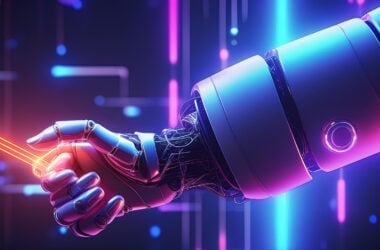In the evolving world of robotics, the Bristol Robotics Laboratory has introduced a significant innovation – the Tetraflex robot. This tetrahedral, shape-shifting robot is engineered to navigate through diverse obstacles.

Tetraflex is not your standard robot. Its design blends soft and rigid components, allowing it to adapt to various environments quickly. The robot comprises weak struts connected by fixed nodes, each mount formed of an airtight rubber below. The manipulation of air pressure within these bellows enables the Tetraflex to change its shape and size, a feature central to its versatility.
Higher air pressures cause the bellows to extend, while lower pressures lead to contraction. This dynamic allows the robot to roll, crawl, or bind, adapting its form to navigate through tight spaces, traverse harsh terrains, and safely transport fragile objects within its structure. Its ability to change shape is innovative and a functional asset to navigating complex environments. It can crawl through small gaps, making it a potential tool for exploring confined spaces or inspecting structures post-natural disasters. Its performance in the RoboSoft 2022 Locomotion Competition, where it demonstrated its ability to travel over sand and navigate narrow gaps, underscores its potential in real-world applications.
These applications are potentially as diverse as their forms. Its ability to navigate challenging terrains and small spaces can be invaluable in search and rescue missions. The robot can roll over and encapsulate objects, then crawl to transport them safely – a feature that can be instrumental in collecting samples from hostile environments like nuclear sites or distant planets. Space exploration and ecological surveying are other fields where Tetraflex can significantly impact. Its ability to change shape enables it to navigate other planets’ unpredictable and often hostile terrains, while its object transport capability can aid in sample collection and data gathering.
The journey of Tetraflex from a concept to a working robotic prototype highlights the role of good engineering processes – innovation and refinement. The team is now eyeing the integration of machine learning algorithms to explore and optimize movement patterns further. The goal is to enhance the robot’s existing capabilities and discover new, efficient ways of interacting with diverse environments.
Peter Wharton, a lead author from Bristol’s School of Engineering Mathematics and Technology, encapsulates the excitement and potential surrounding Tetraflex. Speaking ‘imeche’, he explained that the robot’s versatility and adaptability are not just technical achievements but open doors to possibilities yet explored in robotics and that “there could be some really creative and effective ways of moving around or interacting with the environment that we haven’t yet discovered.”
The Tetraflex robot’s ability to change shape and adapt to diverse environments underscores the potential of flexible design in addressing real-world challenges. As research and development continue, the Tetraflex is poised to expand its capabilities and redefine the boundaries of robotic applications in diverse fields. As we anticipate future results, one thing is clear – the Tetraflex robot is a technological innovation and a glimpse into a future where robots can adapt, evolve, and respond to the multifaceted challenges of diverse environments with unprecedented efficiency and versatility.
TLDR
- The Tetraflex is a shape-shifting robot developed by the University of Bristol and Bristol Robotics Laboratory, capable of navigating diverse obstacles.
- Its design involves soft struts and rigid nodes manipulated by air pressure, allowing shape and size changes for various locomotion methods.
- The robot can be used in search and rescue, space exploration, and ecological surveying due to its ability to traverse challenging terrains and transport objects safely.
- Future developments include integrating machine learning to optimize and explore new movement patterns.








